Analyzing Cancer Drug Approval: A Study of EU and USA Frameworks
VerifiedAdded on 2023/03/30
|55
|14227
|222
Thesis and Dissertation
AI Summary
This thesis provides a comparative analysis of the cancer drug approval processes in the European Union (EU) and the United States of America (USA), focusing on the roles of the European Medicines Agency (EMA) and the Food and Drug Administration (FDA). It explores the complexities, challenges, and implications associated with the drug development and approval framework in both regions. The study uses secondary data collection and mixed-method analysis to scrutinize the data. It addresses ethical considerations and aims to enhance knowledge and application towards more patient-centered care and a more rapid, yet quality-driven, drug approval process. The research also recommends potential joint research initiatives between the FDA and EMA to validate results and decrease research expenditure, ultimately improving the efficiency and effectiveness of cancer drug approvals.

NAME: KALYAN CHALAMCHARLA
STDENT ID: C00243361
TITLE: CANCER DRUGS APPROVAL PROCESS IN EU AND USA
STDENT ID: C00243361
TITLE: CANCER DRUGS APPROVAL PROCESS IN EU AND USA
Paraphrase This Document
Need a fresh take? Get an instant paraphrase of this document with our AI Paraphraser
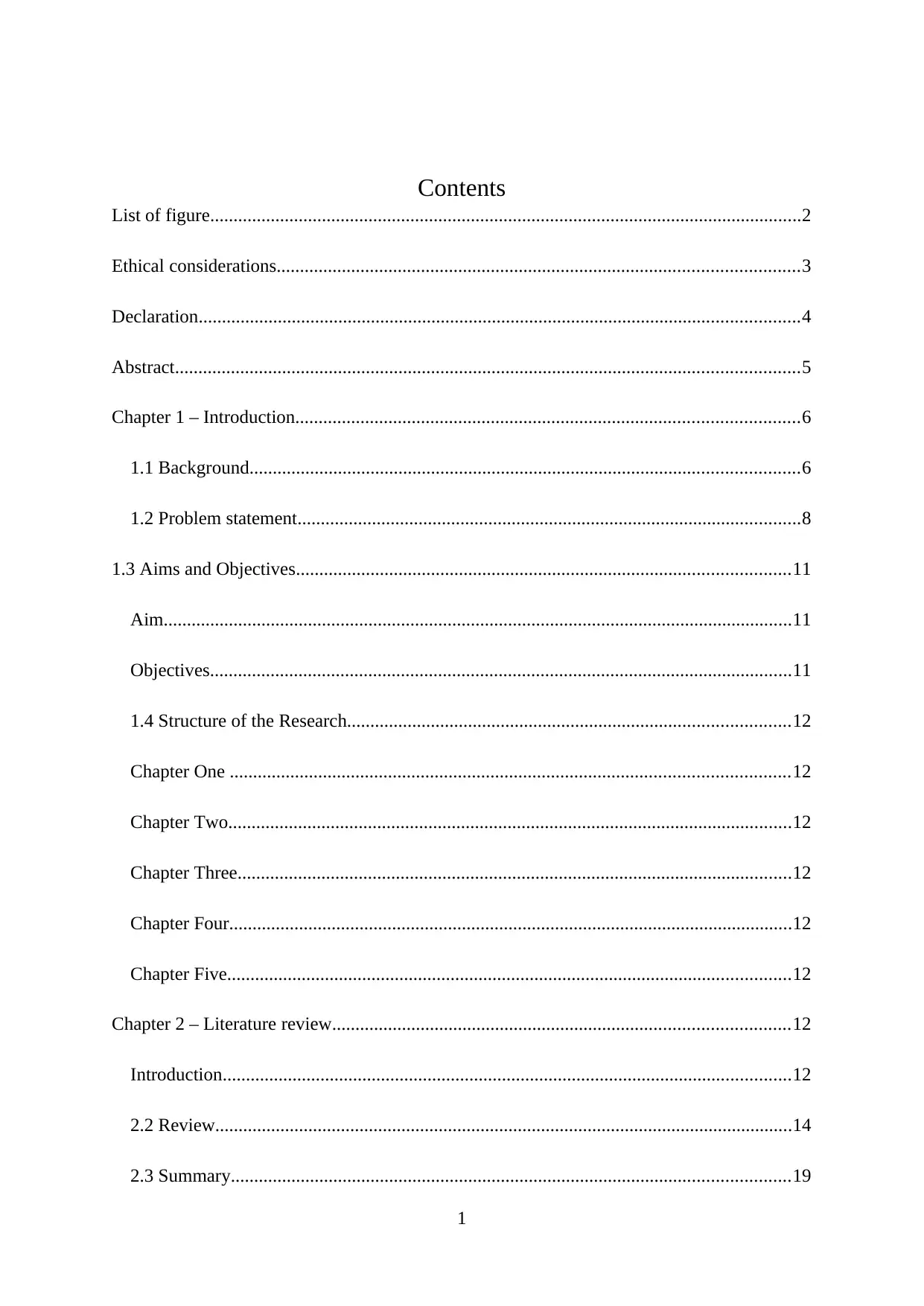
Contents
List of figure...............................................................................................................................2
Ethical considerations................................................................................................................3
Declaration.................................................................................................................................4
Abstract......................................................................................................................................5
Chapter 1 – Introduction............................................................................................................6
1.1 Background......................................................................................................................6
1.2 Problem statement............................................................................................................8
1.3 Aims and Objectives..........................................................................................................11
Aim.......................................................................................................................................11
Objectives.............................................................................................................................11
1.4 Structure of the Research...............................................................................................12
Chapter One ........................................................................................................................12
Chapter Two.........................................................................................................................12
Chapter Three.......................................................................................................................12
Chapter Four.........................................................................................................................12
Chapter Five.........................................................................................................................12
Chapter 2 – Literature review..................................................................................................12
Introduction..........................................................................................................................12
2.2 Review............................................................................................................................14
2.3 Summary........................................................................................................................19
1
List of figure...............................................................................................................................2
Ethical considerations................................................................................................................3
Declaration.................................................................................................................................4
Abstract......................................................................................................................................5
Chapter 1 – Introduction............................................................................................................6
1.1 Background......................................................................................................................6
1.2 Problem statement............................................................................................................8
1.3 Aims and Objectives..........................................................................................................11
Aim.......................................................................................................................................11
Objectives.............................................................................................................................11
1.4 Structure of the Research...............................................................................................12
Chapter One ........................................................................................................................12
Chapter Two.........................................................................................................................12
Chapter Three.......................................................................................................................12
Chapter Four.........................................................................................................................12
Chapter Five.........................................................................................................................12
Chapter 2 – Literature review..................................................................................................12
Introduction..........................................................................................................................12
2.2 Review............................................................................................................................14
2.3 Summary........................................................................................................................19
1
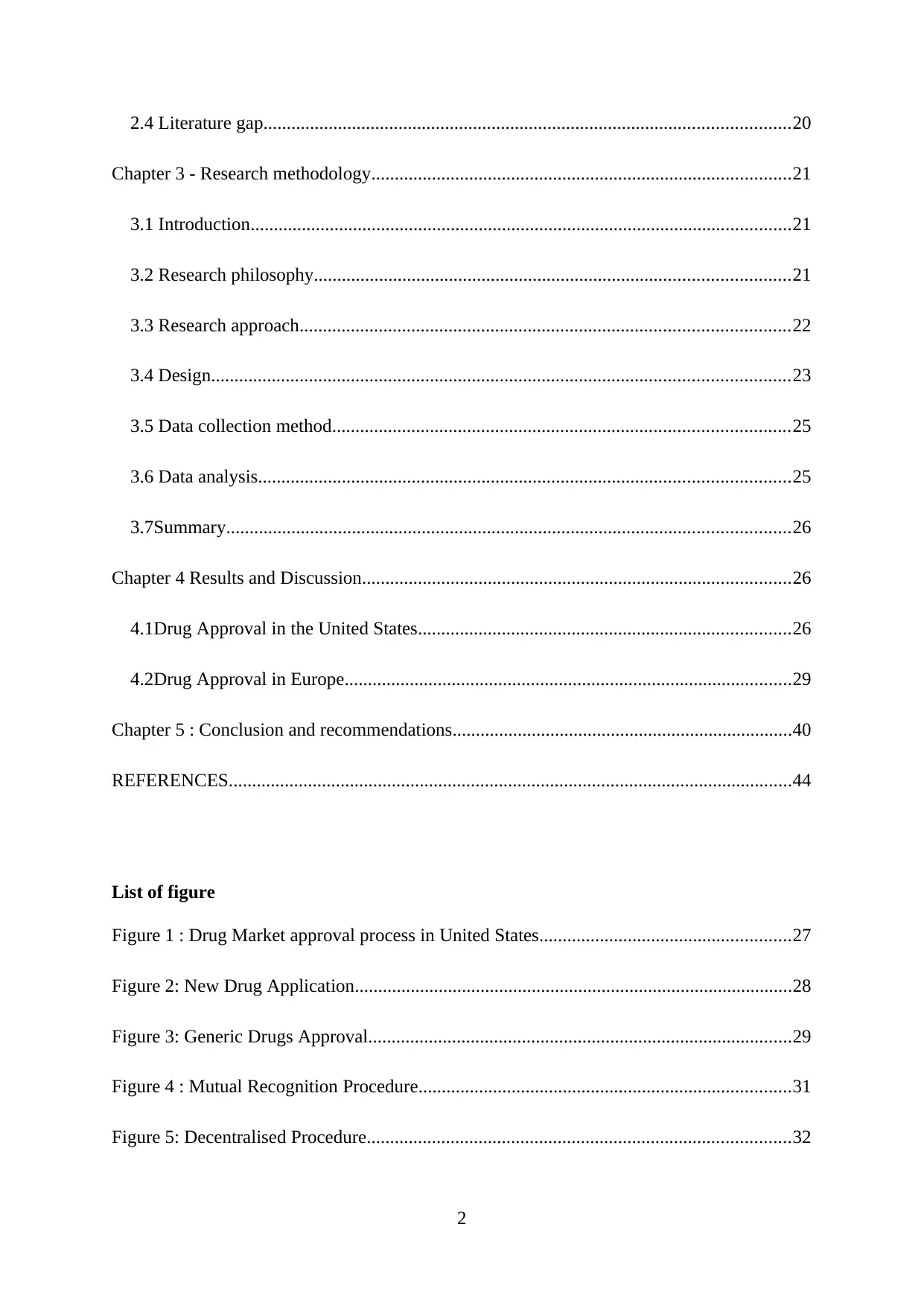
2.4 Literature gap.................................................................................................................20
Chapter 3 - Research methodology..........................................................................................21
3.1 Introduction....................................................................................................................21
3.2 Research philosophy......................................................................................................21
3.3 Research approach.........................................................................................................22
3.4 Design............................................................................................................................23
3.5 Data collection method..................................................................................................25
3.6 Data analysis..................................................................................................................25
3.7Summary.........................................................................................................................26
Chapter 4 Results and Discussion............................................................................................26
4.1Drug Approval in the United States................................................................................26
4.2Drug Approval in Europe................................................................................................29
Chapter 5 : Conclusion and recommendations.........................................................................40
REFERENCES.........................................................................................................................44
List of figure
Figure 1 : Drug Market approval process in United States......................................................27
Figure 2: New Drug Application..............................................................................................28
Figure 3: Generic Drugs Approval...........................................................................................29
Figure 4 : Mutual Recognition Procedure................................................................................31
Figure 5: Decentralised Procedure...........................................................................................32
2
Chapter 3 - Research methodology..........................................................................................21
3.1 Introduction....................................................................................................................21
3.2 Research philosophy......................................................................................................21
3.3 Research approach.........................................................................................................22
3.4 Design............................................................................................................................23
3.5 Data collection method..................................................................................................25
3.6 Data analysis..................................................................................................................25
3.7Summary.........................................................................................................................26
Chapter 4 Results and Discussion............................................................................................26
4.1Drug Approval in the United States................................................................................26
4.2Drug Approval in Europe................................................................................................29
Chapter 5 : Conclusion and recommendations.........................................................................40
REFERENCES.........................................................................................................................44
List of figure
Figure 1 : Drug Market approval process in United States......................................................27
Figure 2: New Drug Application..............................................................................................28
Figure 3: Generic Drugs Approval...........................................................................................29
Figure 4 : Mutual Recognition Procedure................................................................................31
Figure 5: Decentralised Procedure...........................................................................................32
2
⊘ This is a preview!⊘
Do you want full access?
Subscribe today to unlock all pages.

Trusted by 1+ million students worldwide
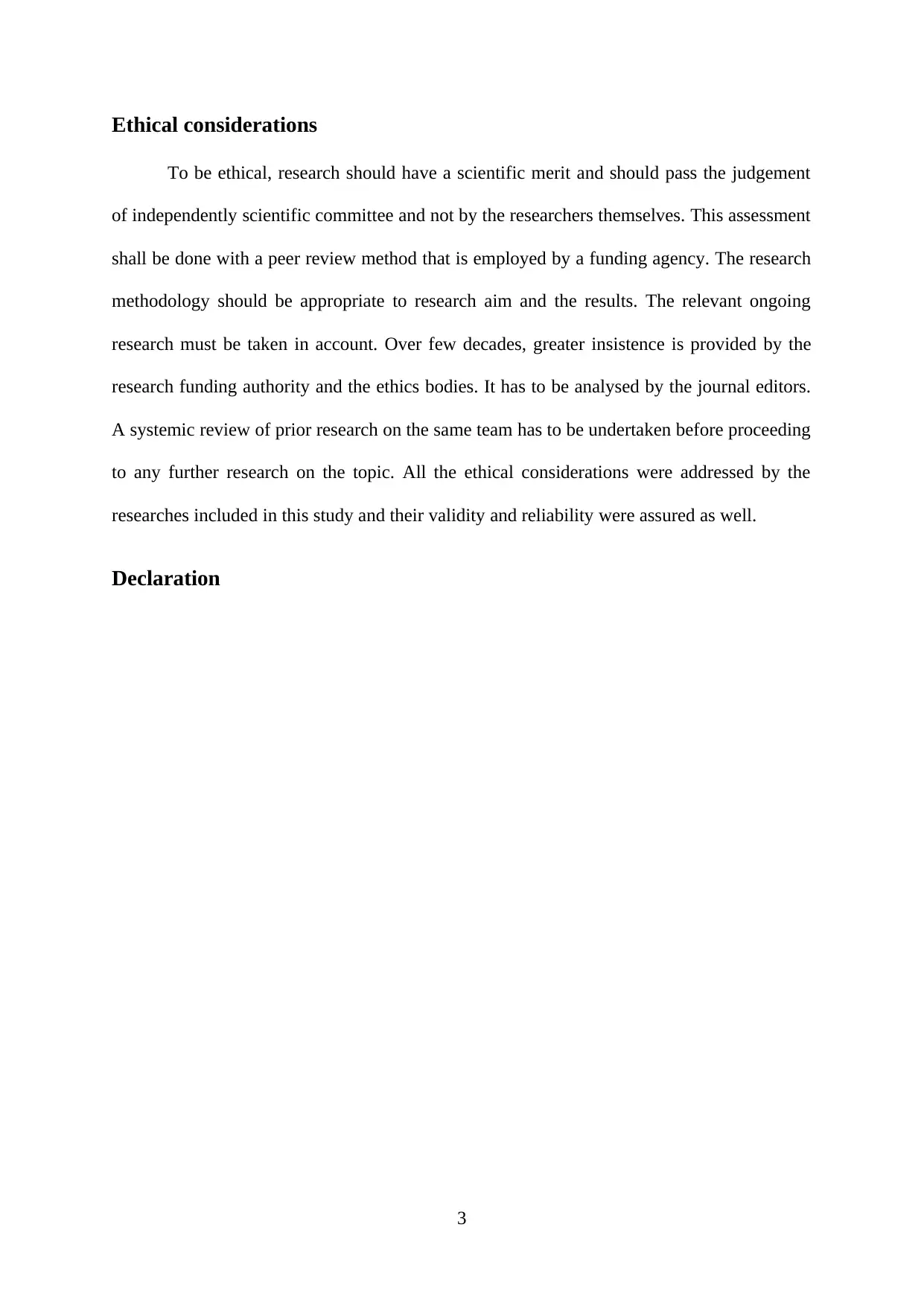
Ethical considerations
To be ethical, research should have a scientific merit and should pass the judgement
of independently scientific committee and not by the researchers themselves. This assessment
shall be done with a peer review method that is employed by a funding agency. The research
methodology should be appropriate to research aim and the results. The relevant ongoing
research must be taken in account. Over few decades, greater insistence is provided by the
research funding authority and the ethics bodies. It has to be analysed by the journal editors.
A systemic review of prior research on the same team has to be undertaken before proceeding
to any further research on the topic. All the ethical considerations were addressed by the
researches included in this study and their validity and reliability were assured as well.
Declaration
3
To be ethical, research should have a scientific merit and should pass the judgement
of independently scientific committee and not by the researchers themselves. This assessment
shall be done with a peer review method that is employed by a funding agency. The research
methodology should be appropriate to research aim and the results. The relevant ongoing
research must be taken in account. Over few decades, greater insistence is provided by the
research funding authority and the ethics bodies. It has to be analysed by the journal editors.
A systemic review of prior research on the same team has to be undertaken before proceeding
to any further research on the topic. All the ethical considerations were addressed by the
researches included in this study and their validity and reliability were assured as well.
Declaration
3
Paraphrase This Document
Need a fresh take? Get an instant paraphrase of this document with our AI Paraphraser

Abstract
Drug approval process in Europe and United States is a lengthy and complicated
process that influence the expenditure, waiting time and market availability of the drugs in a
a drastic way. While quality, risk and safety issues are common with the drugs approved by
FDA of United States ad EMA of Europe – these agencies continues to evolve with the
demands for new generations of drugs. Oncology drugs, used for different cancer conditions
are novelistic and they involve a pathbreaking research approach with adherence to quality
constraints and market demands. The problems though, lies within each step of the drug
approval process from its initial development to its administration to the patients and the drug
reviews related to the same. The study aims to drug approval process in cancer drugs in
European Union and United States of America. The study uses a secondary data collection
and a mixed metod analysis to gather and scrutinize te data. This research study explores the
research problem from new perspectives and attempts to understand the cancer drug approval
process of both the agengies while highlighting the complexities and implication present with
the drug development and drug approval framework. The study recommends new ways of
dealing with the issues associated with the drug approval process in general and cancer drg
approval process in specific as it takes into count, a possibility of joint research by FDA and
EMA, in order to validate the results and decrease the research expenditure. The research
study is determined to enance knowledge and application to a more patient centred care and
more rapid but quality drug approval process.
4
Drug approval process in Europe and United States is a lengthy and complicated
process that influence the expenditure, waiting time and market availability of the drugs in a
a drastic way. While quality, risk and safety issues are common with the drugs approved by
FDA of United States ad EMA of Europe – these agencies continues to evolve with the
demands for new generations of drugs. Oncology drugs, used for different cancer conditions
are novelistic and they involve a pathbreaking research approach with adherence to quality
constraints and market demands. The problems though, lies within each step of the drug
approval process from its initial development to its administration to the patients and the drug
reviews related to the same. The study aims to drug approval process in cancer drugs in
European Union and United States of America. The study uses a secondary data collection
and a mixed metod analysis to gather and scrutinize te data. This research study explores the
research problem from new perspectives and attempts to understand the cancer drug approval
process of both the agengies while highlighting the complexities and implication present with
the drug development and drug approval framework. The study recommends new ways of
dealing with the issues associated with the drug approval process in general and cancer drg
approval process in specific as it takes into count, a possibility of joint research by FDA and
EMA, in order to validate the results and decrease the research expenditure. The research
study is determined to enance knowledge and application to a more patient centred care and
more rapid but quality drug approval process.
4
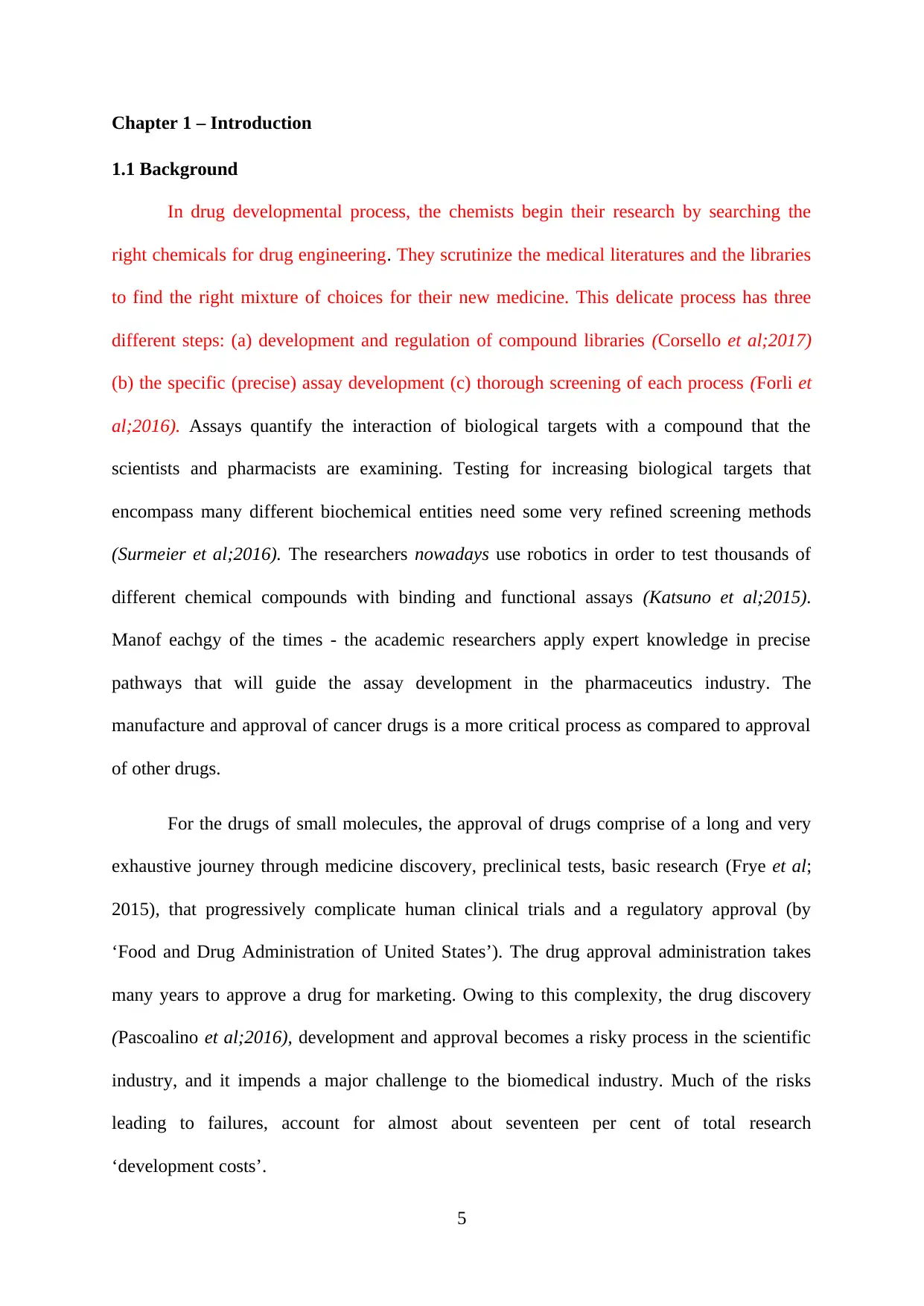
Chapter 1 – Introduction
1.1 Background
In drug developmental process, the chemists begin their research by searching the
right chemicals for drug engineering. They scrutinize the medical literatures and the libraries
to find the right mixture of choices for their new medicine. This delicate process has three
different steps: (a) development and regulation of compound libraries (Corsello et al;2017)
(b) the specific (precise) assay development (c) thorough screening of each process (Forli et
al;2016). Assays quantify the interaction of biological targets with a compound that the
scientists and pharmacists are examining. Testing for increasing biological targets that
encompass many different biochemical entities need some very refined screening methods
(Surmeier et al;2016). The researchers nowadays use robotics in order to test thousands of
different chemical compounds with binding and functional assays (Katsuno et al;2015).
Manof eachgy of the times - the academic researchers apply expert knowledge in precise
pathways that will guide the assay development in the pharmaceutics industry. The
manufacture and approval of cancer drugs is a more critical process as compared to approval
of other drugs.
For the drugs of small molecules, the approval of drugs comprise of a long and very
exhaustive journey through medicine discovery, preclinical tests, basic research (Frye et al;
2015), that progressively complicate human clinical trials and a regulatory approval (by
‘Food and Drug Administration of United States’). The drug approval administration takes
many years to approve a drug for marketing. Owing to this complexity, the drug discovery
(Pascoalino et al;2016), development and approval becomes a risky process in the scientific
industry, and it impends a major challenge to the biomedical industry. Much of the risks
leading to failures, account for almost about seventeen per cent of total research
‘development costs’.
5
1.1 Background
In drug developmental process, the chemists begin their research by searching the
right chemicals for drug engineering. They scrutinize the medical literatures and the libraries
to find the right mixture of choices for their new medicine. This delicate process has three
different steps: (a) development and regulation of compound libraries (Corsello et al;2017)
(b) the specific (precise) assay development (c) thorough screening of each process (Forli et
al;2016). Assays quantify the interaction of biological targets with a compound that the
scientists and pharmacists are examining. Testing for increasing biological targets that
encompass many different biochemical entities need some very refined screening methods
(Surmeier et al;2016). The researchers nowadays use robotics in order to test thousands of
different chemical compounds with binding and functional assays (Katsuno et al;2015).
Manof eachgy of the times - the academic researchers apply expert knowledge in precise
pathways that will guide the assay development in the pharmaceutics industry. The
manufacture and approval of cancer drugs is a more critical process as compared to approval
of other drugs.
For the drugs of small molecules, the approval of drugs comprise of a long and very
exhaustive journey through medicine discovery, preclinical tests, basic research (Frye et al;
2015), that progressively complicate human clinical trials and a regulatory approval (by
‘Food and Drug Administration of United States’). The drug approval administration takes
many years to approve a drug for marketing. Owing to this complexity, the drug discovery
(Pascoalino et al;2016), development and approval becomes a risky process in the scientific
industry, and it impends a major challenge to the biomedical industry. Much of the risks
leading to failures, account for almost about seventeen per cent of total research
‘development costs’.
5
⊘ This is a preview!⊘
Do you want full access?
Subscribe today to unlock all pages.

Trusted by 1+ million students worldwide
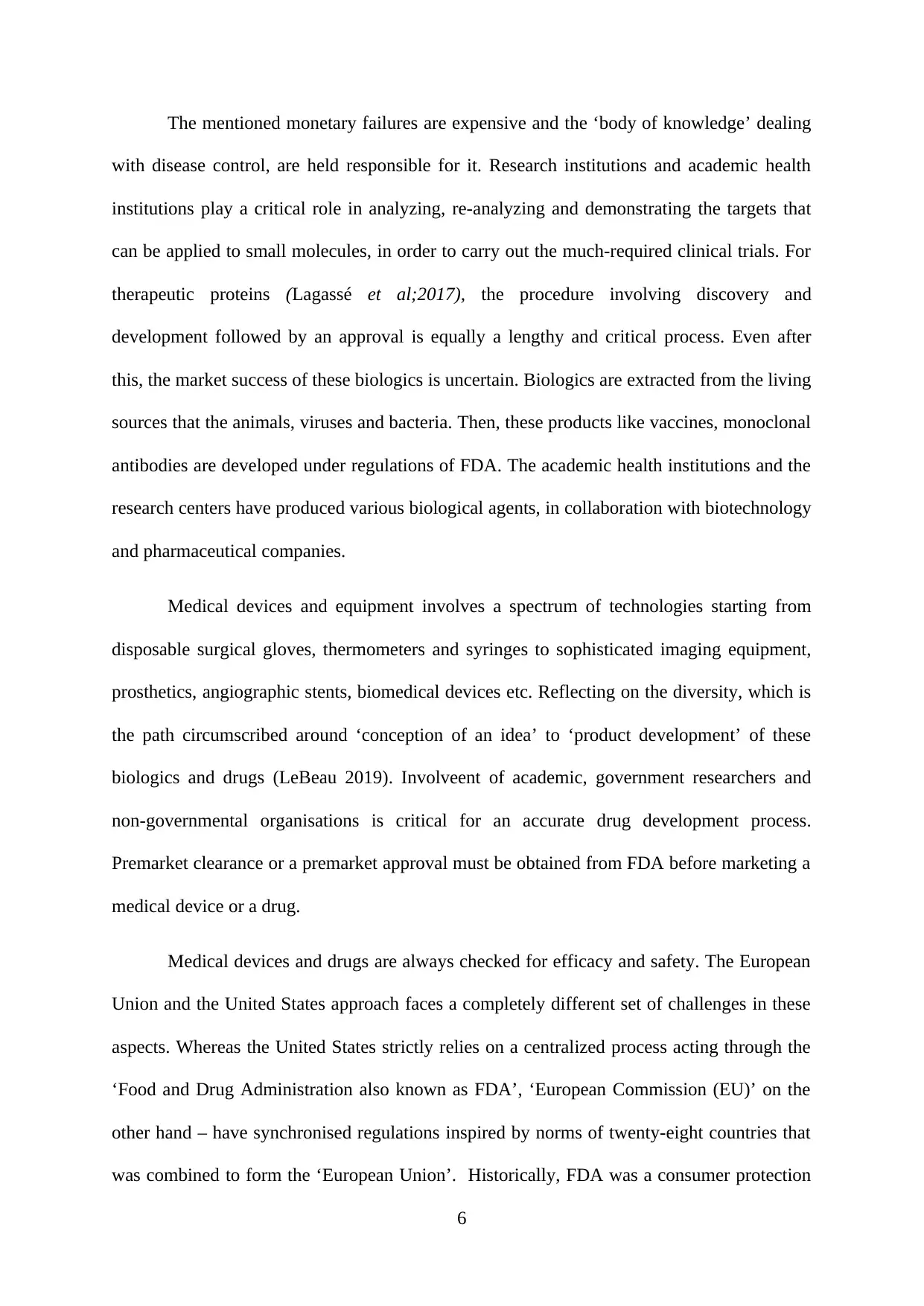
The mentioned monetary failures are expensive and the ‘body of knowledge’ dealing
with disease control, are held responsible for it. Research institutions and academic health
institutions play a critical role in analyzing, re-analyzing and demonstrating the targets that
can be applied to small molecules, in order to carry out the much-required clinical trials. For
therapeutic proteins (Lagassé et al;2017), the procedure involving discovery and
development followed by an approval is equally a lengthy and critical process. Even after
this, the market success of these biologics is uncertain. Biologics are extracted from the living
sources that the animals, viruses and bacteria. Then, these products like vaccines, monoclonal
antibodies are developed under regulations of FDA. The academic health institutions and the
research centers have produced various biological agents, in collaboration with biotechnology
and pharmaceutical companies.
Medical devices and equipment involves a spectrum of technologies starting from
disposable surgical gloves, thermometers and syringes to sophisticated imaging equipment,
prosthetics, angiographic stents, biomedical devices etc. Reflecting on the diversity, which is
the path circumscribed around ‘conception of an idea’ to ‘product development’ of these
biologics and drugs (LeBeau 2019). Involveent of academic, government researchers and
non-governmental organisations is critical for an accurate drug development process.
Premarket clearance or a premarket approval must be obtained from FDA before marketing a
medical device or a drug.
Medical devices and drugs are always checked for efficacy and safety. The European
Union and the United States approach faces a completely different set of challenges in these
aspects. Whereas the United States strictly relies on a centralized process acting through the
‘Food and Drug Administration also known as FDA’, ‘European Commission (EU)’ on the
other hand – have synchronised regulations inspired by norms of twenty-eight countries that
was combined to form the ‘European Union’. Historically, FDA was a consumer protection
6
with disease control, are held responsible for it. Research institutions and academic health
institutions play a critical role in analyzing, re-analyzing and demonstrating the targets that
can be applied to small molecules, in order to carry out the much-required clinical trials. For
therapeutic proteins (Lagassé et al;2017), the procedure involving discovery and
development followed by an approval is equally a lengthy and critical process. Even after
this, the market success of these biologics is uncertain. Biologics are extracted from the living
sources that the animals, viruses and bacteria. Then, these products like vaccines, monoclonal
antibodies are developed under regulations of FDA. The academic health institutions and the
research centers have produced various biological agents, in collaboration with biotechnology
and pharmaceutical companies.
Medical devices and equipment involves a spectrum of technologies starting from
disposable surgical gloves, thermometers and syringes to sophisticated imaging equipment,
prosthetics, angiographic stents, biomedical devices etc. Reflecting on the diversity, which is
the path circumscribed around ‘conception of an idea’ to ‘product development’ of these
biologics and drugs (LeBeau 2019). Involveent of academic, government researchers and
non-governmental organisations is critical for an accurate drug development process.
Premarket clearance or a premarket approval must be obtained from FDA before marketing a
medical device or a drug.
Medical devices and drugs are always checked for efficacy and safety. The European
Union and the United States approach faces a completely different set of challenges in these
aspects. Whereas the United States strictly relies on a centralized process acting through the
‘Food and Drug Administration also known as FDA’, ‘European Commission (EU)’ on the
other hand – have synchronised regulations inspired by norms of twenty-eight countries that
was combined to form the ‘European Union’. Historically, FDA was a consumer protection
6
Paraphrase This Document
Need a fresh take? Get an instant paraphrase of this document with our AI Paraphraser

agency while the ‘European Commission’s regulations’ were developed to bring a harmony
in state and nation’s commercial interests. Therefore, while the ‘FDA’ have a prior advantage
of centralization and ground rules – the European Union controls their medical device and
drug approval process through networks of both decentralized and centralised agencies
throughout its member states. There exists certain differences and similarities between ‘U.S
and Europe’s’ regulation of drugs and discusses challenges facing each. This study focusses
on the differences present between the United States and the European’s process of drug
approval.
There persists a discrepancy and controversy while differentiating between the
‘European Union and FDA’s regulatory processes can take both time and costs for a medical
drug and device to progress from the idea to an ‘approval’ under the given regulations. An
assertion process has been reported to be so slow that the FDA approval deprive the
American citizens of effective DADs. The critics have even characterized the FDA as being
slow, expensive and risk aversive. Additionally, the Institute of Medicine analysed that the
pre-marketing procedures of the FDA regarding medical devices is inadequate to ensure the
device safety, specifically of those that is approved largely due to their similarity with
‘predicate’ devices and not on a prospective, randomized clinical studies. The concern
associated with the European Union is that the DADs are approved very quickly which can
prove dangerous for the patient. In current years, there have been many advancements to
tighten the approval processes and to create an effective framework of regulatory policies
between the EU and the FDA (Davit et al; 2016). Efforts involve a recent legislation
proposed by U.S. Congress in order to facilitate a rapid release of drugs in the United States
that are already approved by the European Union.
7
in state and nation’s commercial interests. Therefore, while the ‘FDA’ have a prior advantage
of centralization and ground rules – the European Union controls their medical device and
drug approval process through networks of both decentralized and centralised agencies
throughout its member states. There exists certain differences and similarities between ‘U.S
and Europe’s’ regulation of drugs and discusses challenges facing each. This study focusses
on the differences present between the United States and the European’s process of drug
approval.
There persists a discrepancy and controversy while differentiating between the
‘European Union and FDA’s regulatory processes can take both time and costs for a medical
drug and device to progress from the idea to an ‘approval’ under the given regulations. An
assertion process has been reported to be so slow that the FDA approval deprive the
American citizens of effective DADs. The critics have even characterized the FDA as being
slow, expensive and risk aversive. Additionally, the Institute of Medicine analysed that the
pre-marketing procedures of the FDA regarding medical devices is inadequate to ensure the
device safety, specifically of those that is approved largely due to their similarity with
‘predicate’ devices and not on a prospective, randomized clinical studies. The concern
associated with the European Union is that the DADs are approved very quickly which can
prove dangerous for the patient. In current years, there have been many advancements to
tighten the approval processes and to create an effective framework of regulatory policies
between the EU and the FDA (Davit et al; 2016). Efforts involve a recent legislation
proposed by U.S. Congress in order to facilitate a rapid release of drugs in the United States
that are already approved by the European Union.
7
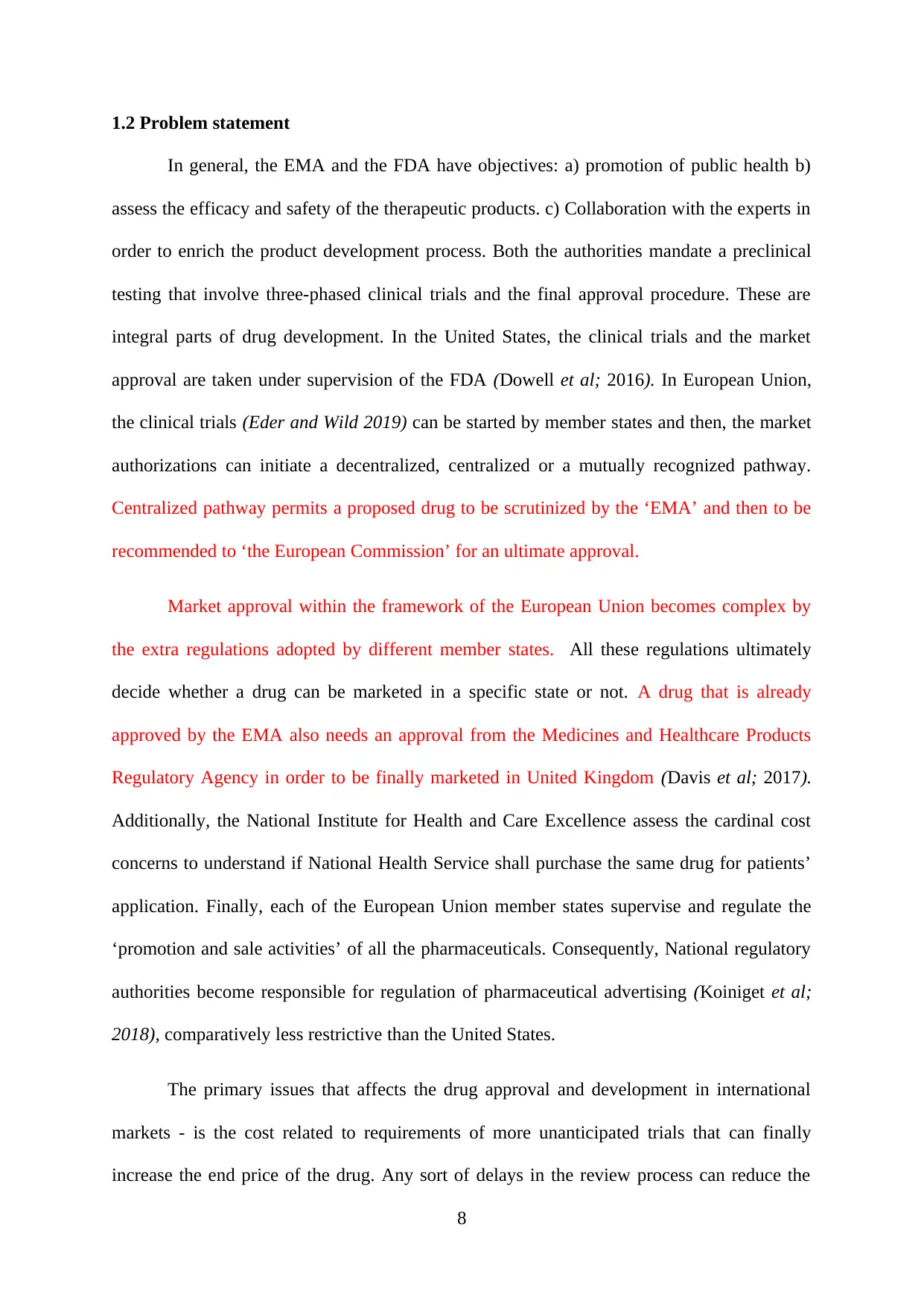
1.2 Problem statement
In general, the EMA and the FDA have objectives: a) promotion of public health b)
assess the efficacy and safety of the therapeutic products. c) Collaboration with the experts in
order to enrich the product development process. Both the authorities mandate a preclinical
testing that involve three-phased clinical trials and the final approval procedure. These are
integral parts of drug development. In the United States, the clinical trials and the market
approval are taken under supervision of the FDA (Dowell et al; 2016). In European Union,
the clinical trials (Eder and Wild 2019) can be started by member states and then, the market
authorizations can initiate a decentralized, centralized or a mutually recognized pathway.
Centralized pathway permits a proposed drug to be scrutinized by the ‘EMA’ and then to be
recommended to ‘the European Commission’ for an ultimate approval.
Market approval within the framework of the European Union becomes complex by
the extra regulations adopted by different member states. All these regulations ultimately
decide whether a drug can be marketed in a specific state or not. A drug that is already
approved by the EMA also needs an approval from the Medicines and Healthcare Products
Regulatory Agency in order to be finally marketed in United Kingdom (Davis et al; 2017).
Additionally, the National Institute for Health and Care Excellence assess the cardinal cost
concerns to understand if National Health Service shall purchase the same drug for patients’
application. Finally, each of the European Union member states supervise and regulate the
‘promotion and sale activities’ of all the pharmaceuticals. Consequently, National regulatory
authorities become responsible for regulation of pharmaceutical advertising (Koiniget et al;
2018), comparatively less restrictive than the United States.
The primary issues that affects the drug approval and development in international
markets - is the cost related to requirements of more unanticipated trials that can finally
increase the end price of the drug. Any sort of delays in the review process can reduce the
8
In general, the EMA and the FDA have objectives: a) promotion of public health b)
assess the efficacy and safety of the therapeutic products. c) Collaboration with the experts in
order to enrich the product development process. Both the authorities mandate a preclinical
testing that involve three-phased clinical trials and the final approval procedure. These are
integral parts of drug development. In the United States, the clinical trials and the market
approval are taken under supervision of the FDA (Dowell et al; 2016). In European Union,
the clinical trials (Eder and Wild 2019) can be started by member states and then, the market
authorizations can initiate a decentralized, centralized or a mutually recognized pathway.
Centralized pathway permits a proposed drug to be scrutinized by the ‘EMA’ and then to be
recommended to ‘the European Commission’ for an ultimate approval.
Market approval within the framework of the European Union becomes complex by
the extra regulations adopted by different member states. All these regulations ultimately
decide whether a drug can be marketed in a specific state or not. A drug that is already
approved by the EMA also needs an approval from the Medicines and Healthcare Products
Regulatory Agency in order to be finally marketed in United Kingdom (Davis et al; 2017).
Additionally, the National Institute for Health and Care Excellence assess the cardinal cost
concerns to understand if National Health Service shall purchase the same drug for patients’
application. Finally, each of the European Union member states supervise and regulate the
‘promotion and sale activities’ of all the pharmaceuticals. Consequently, National regulatory
authorities become responsible for regulation of pharmaceutical advertising (Koiniget et al;
2018), comparatively less restrictive than the United States.
The primary issues that affects the drug approval and development in international
markets - is the cost related to requirements of more unanticipated trials that can finally
increase the end price of the drug. Any sort of delays in the review process can reduce the
8
⊘ This is a preview!⊘
Do you want full access?
Subscribe today to unlock all pages.

Trusted by 1+ million students worldwide
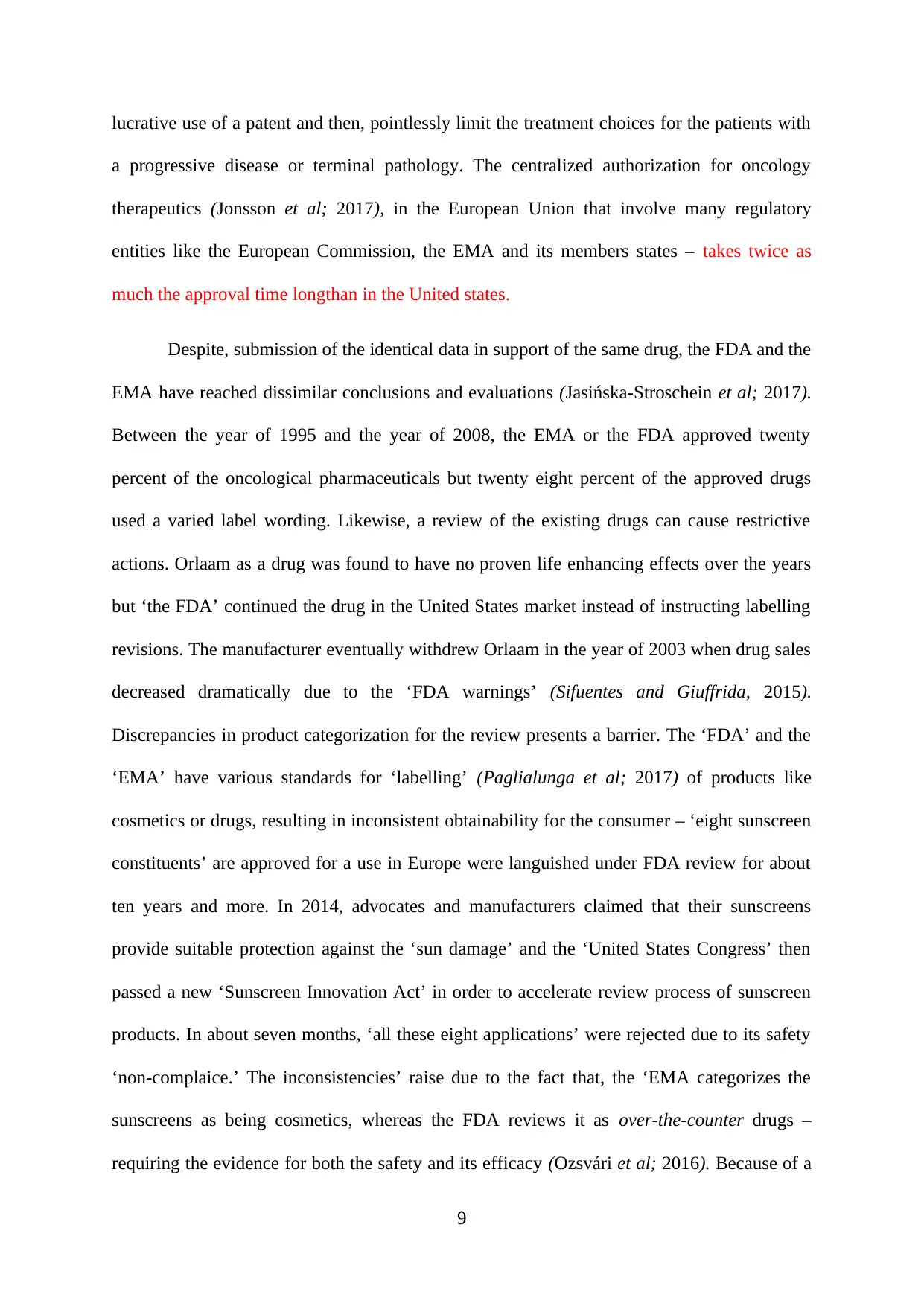
lucrative use of a patent and then, pointlessly limit the treatment choices for the patients with
a progressive disease or terminal pathology. The centralized authorization for oncology
therapeutics (Jonsson et al; 2017), in the European Union that involve many regulatory
entities like the European Commission, the EMA and its members states – takes twice as
much the approval time longthan in the United states.
Despite, submission of the identical data in support of the same drug, the FDA and the
EMA have reached dissimilar conclusions and evaluations (Jasińska-Stroschein et al; 2017).
Between the year of 1995 and the year of 2008, the EMA or the FDA approved twenty
percent of the oncological pharmaceuticals but twenty eight percent of the approved drugs
used a varied label wording. Likewise, a review of the existing drugs can cause restrictive
actions. Orlaam as a drug was found to have no proven life enhancing effects over the years
but ‘the FDA’ continued the drug in the United States market instead of instructing labelling
revisions. The manufacturer eventually withdrew Orlaam in the year of 2003 when drug sales
decreased dramatically due to the ‘FDA warnings’ (Sifuentes and Giuffrida, 2015).
Discrepancies in product categorization for the review presents a barrier. The ‘FDA’ and the
‘EMA’ have various standards for ‘labelling’ (Paglialunga et al; 2017) of products like
cosmetics or drugs, resulting in inconsistent obtainability for the consumer – ‘eight sunscreen
constituents’ are approved for a use in Europe were languished under FDA review for about
ten years and more. In 2014, advocates and manufacturers claimed that their sunscreens
provide suitable protection against the ‘sun damage’ and the ‘United States Congress’ then
passed a new ‘Sunscreen Innovation Act’ in order to accelerate review process of sunscreen
products. In about seven months, ‘all these eight applications’ were rejected due to its safety
‘non-complaice.’ The inconsistencies’ raise due to the fact that, the ‘EMA categorizes the
sunscreens as being cosmetics, whereas the FDA reviews it as over-the-counter drugs –
requiring the evidence for both the safety and its efficacy (Ozsvári et al; 2016). Because of a
9
a progressive disease or terminal pathology. The centralized authorization for oncology
therapeutics (Jonsson et al; 2017), in the European Union that involve many regulatory
entities like the European Commission, the EMA and its members states – takes twice as
much the approval time longthan in the United states.
Despite, submission of the identical data in support of the same drug, the FDA and the
EMA have reached dissimilar conclusions and evaluations (Jasińska-Stroschein et al; 2017).
Between the year of 1995 and the year of 2008, the EMA or the FDA approved twenty
percent of the oncological pharmaceuticals but twenty eight percent of the approved drugs
used a varied label wording. Likewise, a review of the existing drugs can cause restrictive
actions. Orlaam as a drug was found to have no proven life enhancing effects over the years
but ‘the FDA’ continued the drug in the United States market instead of instructing labelling
revisions. The manufacturer eventually withdrew Orlaam in the year of 2003 when drug sales
decreased dramatically due to the ‘FDA warnings’ (Sifuentes and Giuffrida, 2015).
Discrepancies in product categorization for the review presents a barrier. The ‘FDA’ and the
‘EMA’ have various standards for ‘labelling’ (Paglialunga et al; 2017) of products like
cosmetics or drugs, resulting in inconsistent obtainability for the consumer – ‘eight sunscreen
constituents’ are approved for a use in Europe were languished under FDA review for about
ten years and more. In 2014, advocates and manufacturers claimed that their sunscreens
provide suitable protection against the ‘sun damage’ and the ‘United States Congress’ then
passed a new ‘Sunscreen Innovation Act’ in order to accelerate review process of sunscreen
products. In about seven months, ‘all these eight applications’ were rejected due to its safety
‘non-complaice.’ The inconsistencies’ raise due to the fact that, the ‘EMA categorizes the
sunscreens as being cosmetics, whereas the FDA reviews it as over-the-counter drugs –
requiring the evidence for both the safety and its efficacy (Ozsvári et al; 2016). Because of a
9
Paraphrase This Document
Need a fresh take? Get an instant paraphrase of this document with our AI Paraphraser
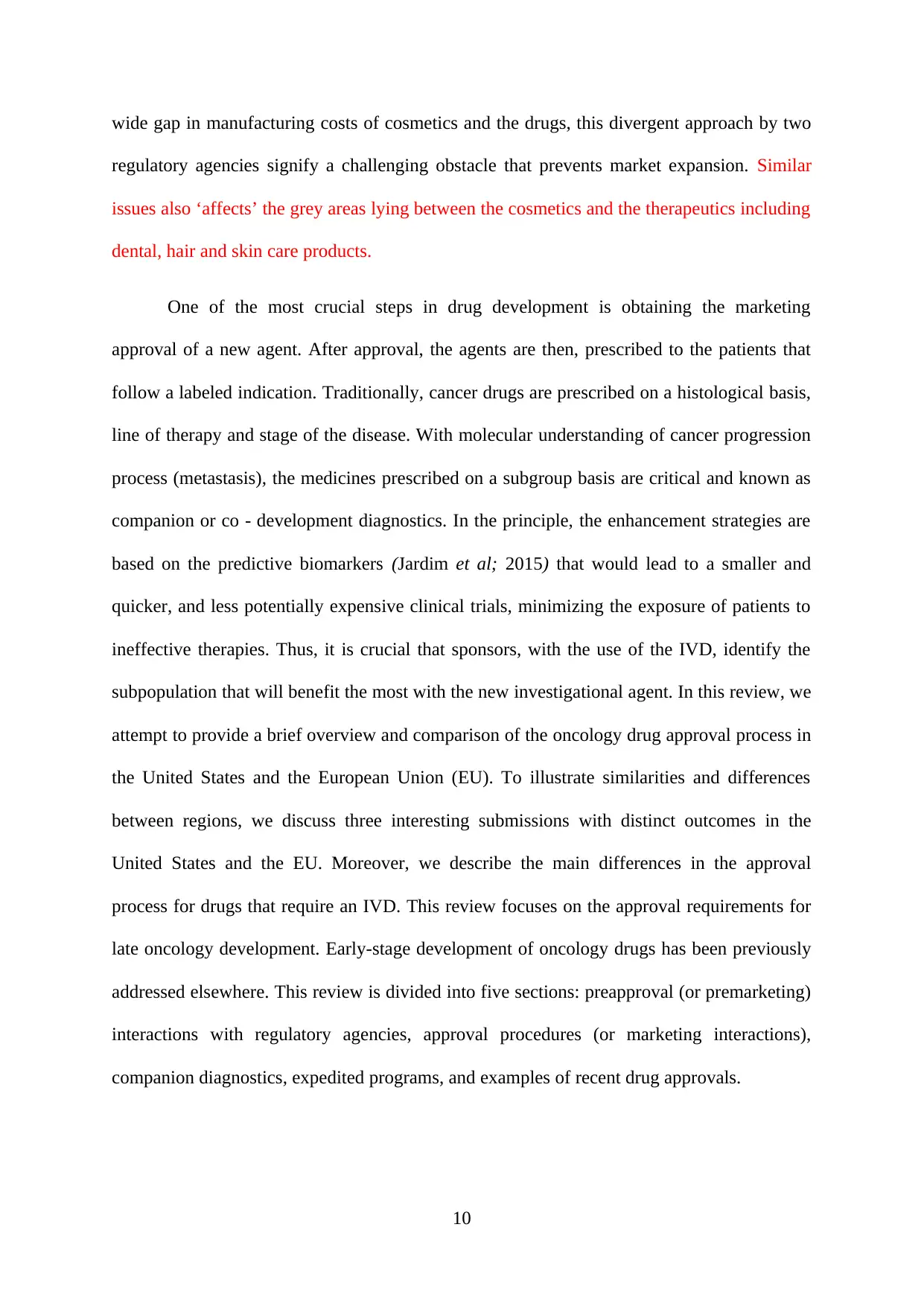
wide gap in manufacturing costs of cosmetics and the drugs, this divergent approach by two
regulatory agencies signify a challenging obstacle that prevents market expansion. Similar
issues also ‘affects’ the grey areas lying between the cosmetics and the therapeutics including
dental, hair and skin care products.
One of the most crucial steps in drug development is obtaining the marketing
approval of a new agent. After approval, the agents are then, prescribed to the patients that
follow a labeled indication. Traditionally, cancer drugs are prescribed on a histological basis,
line of therapy and stage of the disease. With molecular understanding of cancer progression
process (metastasis), the medicines prescribed on a subgroup basis are critical and known as
companion or co - development diagnostics. In the principle, the enhancement strategies are
based on the predictive biomarkers (Jardim et al; 2015) that would lead to a smaller and
quicker, and less potentially expensive clinical trials, minimizing the exposure of patients to
ineffective therapies. Thus, it is crucial that sponsors, with the use of the IVD, identify the
subpopulation that will benefit the most with the new investigational agent. In this review, we
attempt to provide a brief overview and comparison of the oncology drug approval process in
the United States and the European Union (EU). To illustrate similarities and differences
between regions, we discuss three interesting submissions with distinct outcomes in the
United States and the EU. Moreover, we describe the main differences in the approval
process for drugs that require an IVD. This review focuses on the approval requirements for
late oncology development. Early-stage development of oncology drugs has been previously
addressed elsewhere. This review is divided into five sections: preapproval (or premarketing)
interactions with regulatory agencies, approval procedures (or marketing interactions),
companion diagnostics, expedited programs, and examples of recent drug approvals.
10
regulatory agencies signify a challenging obstacle that prevents market expansion. Similar
issues also ‘affects’ the grey areas lying between the cosmetics and the therapeutics including
dental, hair and skin care products.
One of the most crucial steps in drug development is obtaining the marketing
approval of a new agent. After approval, the agents are then, prescribed to the patients that
follow a labeled indication. Traditionally, cancer drugs are prescribed on a histological basis,
line of therapy and stage of the disease. With molecular understanding of cancer progression
process (metastasis), the medicines prescribed on a subgroup basis are critical and known as
companion or co - development diagnostics. In the principle, the enhancement strategies are
based on the predictive biomarkers (Jardim et al; 2015) that would lead to a smaller and
quicker, and less potentially expensive clinical trials, minimizing the exposure of patients to
ineffective therapies. Thus, it is crucial that sponsors, with the use of the IVD, identify the
subpopulation that will benefit the most with the new investigational agent. In this review, we
attempt to provide a brief overview and comparison of the oncology drug approval process in
the United States and the European Union (EU). To illustrate similarities and differences
between regions, we discuss three interesting submissions with distinct outcomes in the
United States and the EU. Moreover, we describe the main differences in the approval
process for drugs that require an IVD. This review focuses on the approval requirements for
late oncology development. Early-stage development of oncology drugs has been previously
addressed elsewhere. This review is divided into five sections: preapproval (or premarketing)
interactions with regulatory agencies, approval procedures (or marketing interactions),
companion diagnostics, expedited programs, and examples of recent drug approvals.
10
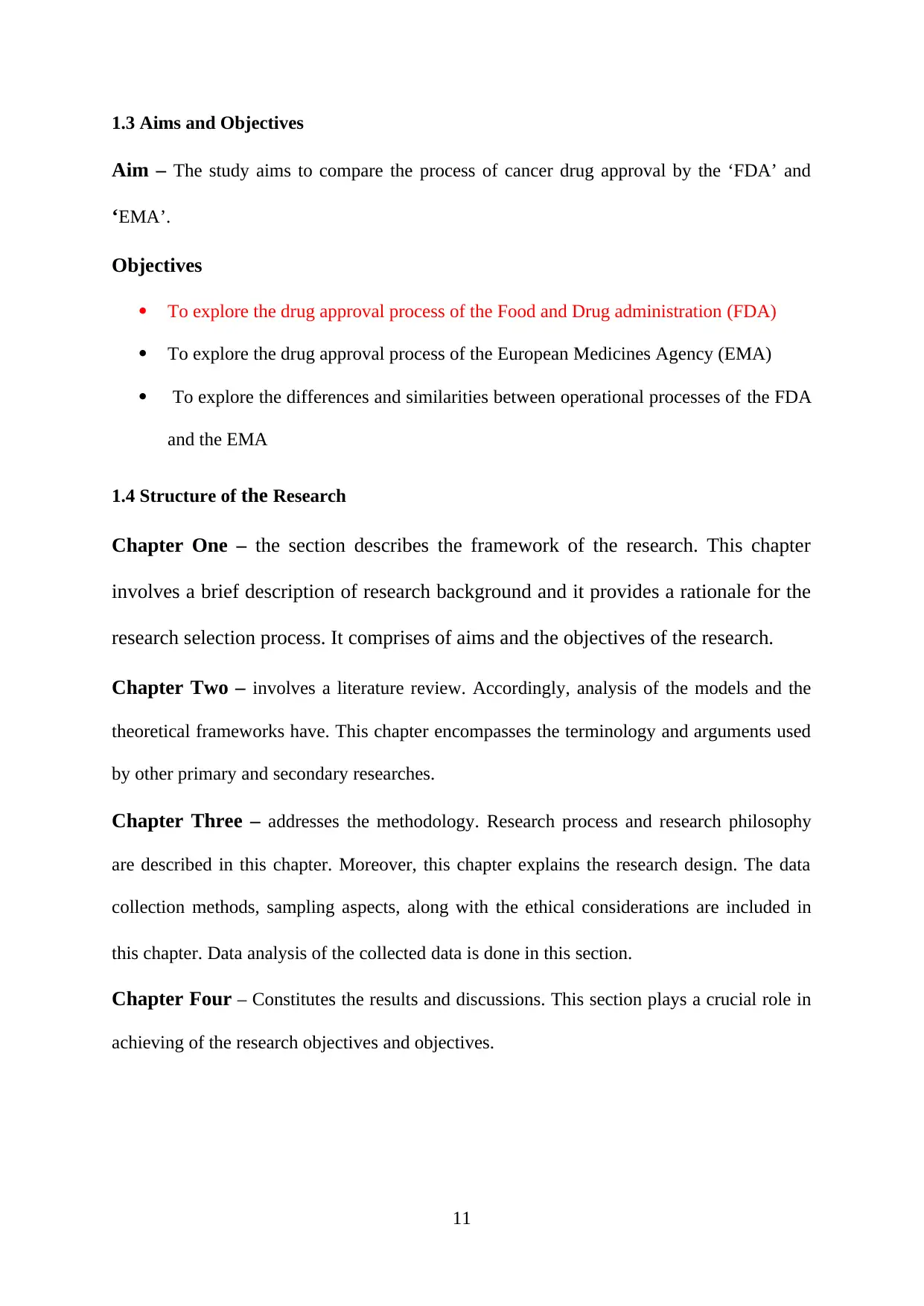
1.3 Aims and Objectives
Aim – The study aims to compare the process of cancer drug approval by the ‘FDA’ and
‘EMA’.
Objectives
To explore the drug approval process of the Food and Drug administration (FDA)
To explore the drug approval process of the European Medicines Agency (EMA)
To explore the differences and similarities between operational processes of the FDA
and the EMA
1.4 Structure of the Research
Chapter One – the section describes the framework of the research. This chapter
involves a brief description of research background and it provides a rationale for the
research selection process. It comprises of aims and the objectives of the research.
Chapter Two – involves a literature review. Accordingly, analysis of the models and the
theoretical frameworks have. This chapter encompasses the terminology and arguments used
by other primary and secondary researches.
Chapter Three – addresses the methodology. Research process and research philosophy
are described in this chapter. Moreover, this chapter explains the research design. The data
collection methods, sampling aspects, along with the ethical considerations are included in
this chapter. Data analysis of the collected data is done in this section.
Chapter Four – Constitutes the results and discussions. This section plays a crucial role in
achieving of the research objectives and objectives.
11
Aim – The study aims to compare the process of cancer drug approval by the ‘FDA’ and
‘EMA’.
Objectives
To explore the drug approval process of the Food and Drug administration (FDA)
To explore the drug approval process of the European Medicines Agency (EMA)
To explore the differences and similarities between operational processes of the FDA
and the EMA
1.4 Structure of the Research
Chapter One – the section describes the framework of the research. This chapter
involves a brief description of research background and it provides a rationale for the
research selection process. It comprises of aims and the objectives of the research.
Chapter Two – involves a literature review. Accordingly, analysis of the models and the
theoretical frameworks have. This chapter encompasses the terminology and arguments used
by other primary and secondary researches.
Chapter Three – addresses the methodology. Research process and research philosophy
are described in this chapter. Moreover, this chapter explains the research design. The data
collection methods, sampling aspects, along with the ethical considerations are included in
this chapter. Data analysis of the collected data is done in this section.
Chapter Four – Constitutes the results and discussions. This section plays a crucial role in
achieving of the research objectives and objectives.
11
⊘ This is a preview!⊘
Do you want full access?
Subscribe today to unlock all pages.

Trusted by 1+ million students worldwide
1 out of 55
Related Documents
Your All-in-One AI-Powered Toolkit for Academic Success.
+13062052269
info@desklib.com
Available 24*7 on WhatsApp / Email
![[object Object]](/_next/static/media/star-bottom.7253800d.svg)
Unlock your academic potential
Copyright © 2020–2025 A2Z Services. All Rights Reserved. Developed and managed by ZUCOL.





